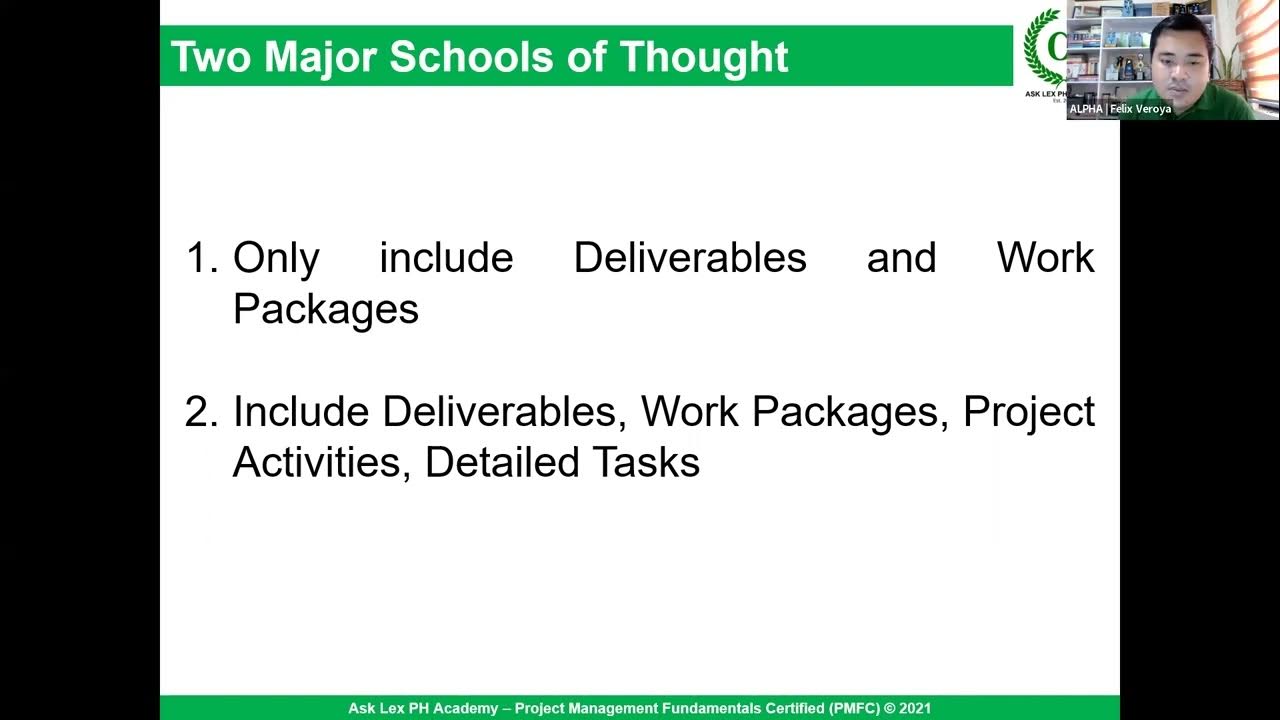Work Breakdown Structures
Summary
TLDRThis video learning session focuses on teaching viewers how to identify project tasks and create a Work Breakdown Structure (WBS). It explains the significance of WBS in project planning, management, and reporting. The session covers the concepts of tasks and milestones, and guides through creating a WBS using both top-down and bottom-up approaches. It also demonstrates how to use Microsoft Project to display a WBS, which is crucial for defining a project's scope and generating project management reports.
Takeaways
- 📚 A Work Breakdown Structure (WBS) is essential for planning, managing, and reporting on a project.
- 🔍 Tasks are defined as work with a start and end that requires resources, while milestones are reference points to monitor project progress.
- 🔼 The WBS can be created using a top-down approach, breaking the project into smaller task groups, or a bottom-up approach, starting with individual tasks.
- 📈 The objective of creating a WBS is to accurately list and describe all tasks in a logical structure.
- 👀 It's crucial to study the project carefully to identify and organize tasks effectively.
- ✍️ Tips for organizing tasks include highlighting task descriptors, converting instructions into a bullet list, and numbering tasks.
- 📊 Task durations can be estimated in hours, days, or weeks, and a formula can be used for a best-case scenario estimate.
- 💻 Microsoft Project is a tool that can display and manage WBS, aiding in project planning and management.
- 📈 The WBS in Microsoft Project includes task numbers, durations, and predecessor tasks, which helps in defining the project and generating reports.
- 📚 Further learning on project management concepts and skills will be covered in subsequent sessions.
Q & A
What is a work breakdown structure (WBS)?
-A work breakdown structure is a key project management tool that breaks down project deliverables and tasks into smaller, more manageable components. It includes task names, durations, predecessor tasks, and related information, which is used to plan, manage, and report on a project.
Why are work breakdown structures important?
-Work breakdown structures are important because they serve as the starting point for any project, helping to define the scope, timeline, and resources required. They also facilitate better project management and reporting.
What are the two methods mentioned for creating a WBS?
-The two methods for creating a WBS are the top-down approach and the bottom-up approach. The top-down approach breaks the project into smaller task groups and then into individual tasks, while the bottom-up approach identifies all tasks first and then builds them into a logical structure.
What is the difference between a task and a milestone?
-A task is any work that has a beginning and an end and requires the use of company resources such as people, time, or money. A milestone, on the other hand, is a reference point that project managers use to monitor progress and oversee the project.
How can you identify tasks from a given set of instructions?
-To identify tasks from instructions, you can highlight the words that describe the tasks themselves, such as 'reserve the meeting room' or 'order the marketing materials'. This helps to distinguish the tasks clearly.
What is the purpose of numbering tasks in a WBS?
-Numbering tasks in a WBS helps in organizing them logically and allows for easier reference and tracking throughout the project lifecycle.
How does Microsoft Project assist in displaying a WBS?
-Microsoft Project is a software application that helps in planning and managing projects. It can display a WBS by providing a structured format with columns for task numbers, durations, and predecessor tasks, which helps in defining the project and generating various charts and reports.
What is the significance of task duration in a WBS?
-Task duration in a WBS is significant as it helps in estimating the time required to complete each task, which is crucial for project scheduling and resource allocation.
How can you estimate task durations in a WBS?
-Task durations can be estimated using various methods, including expert judgment, analogous estimating, parametric estimating, or three-point estimating. The script mentions entering estimated durations without detailing the specific estimation technique.
What are predecessor tasks and why are they important in a WBS?
-Predecessor tasks are tasks that must be completed before another task can begin. They are important in a WBS because they help in defining the sequence of tasks and ensuring that dependencies are managed effectively.
How can you apply the skills learned from this session?
-You can apply the skills learned from this session by creating your own WBS for a project, using the techniques and methods discussed, and then using Microsoft Project or similar tools to display and manage the WBS.
Outlines

このセクションは有料ユーザー限定です。 アクセスするには、アップグレードをお願いします。
今すぐアップグレードMindmap

このセクションは有料ユーザー限定です。 アクセスするには、アップグレードをお願いします。
今すぐアップグレードKeywords

このセクションは有料ユーザー限定です。 アクセスするには、アップグレードをお願いします。
今すぐアップグレードHighlights

このセクションは有料ユーザー限定です。 アクセスするには、アップグレードをお願いします。
今すぐアップグレードTranscripts

このセクションは有料ユーザー限定です。 アクセスするには、アップグレードをお願いします。
今すぐアップグレード5.0 / 5 (0 votes)






